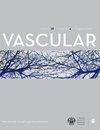伤口淤血能否作为慢性肢体缺血患者终止血管内手术的指标?
IF 0.9
4区 医学
Q4 PERIPHERAL VASCULAR DISEASE
引用次数: 0
摘要
导言预测患有足部伤口的慢性肢体缺血(CLTI)患者血管内再通术的疗效具有挑战性。血管造影伤口红晕(WB)评估被认为是评估伤口灌注的有效工具。本研究旨在评估CLTI患者血管内再通术期间的WB及其对治疗结果的影响。方法这项前瞻性研究纳入了2019年至2021年期间成功接受腹股沟下动脉疾病血管内再通术的所有足部伤口CLTI患者。根据 WB 状态将患者分为阳性 WB(A 组)和阴性 WB(B 组)。两组患者的人口统计学、合并症、临床表现以及12个月的肢体通畅率(LBP)和无截肢生存率(AFS)进行了比较。结果研究纳入了69名卢瑟福分级为5级(46.4%)和6级(53.6%)的患者,主要动脉病变位于股骨干(58%)或股骨干下段(42%)。完成血管造影显示,38 例(55.1%)患者的 WB 阳性,31 例(44.9%)患者的 WB 阴性。两组患者在发病情况、主要动脉病变部位以及足部病变与供血动脉的分布关系方面具有可比性。12个月的总体LBP和AFS率分别为21.7%和39.1%,A组明显优于B组(LBP,31.6% vs 9.7%,p = 0.001;AFS,54.1% vs 22.2%,p = 0.006)。38名患者(55.1%)成功实现了血管造影剂直接流入足部,12个月的AFS率明显高于间接血管再通组(分别为54.8% vs 26.3%,p = 0.036),尽管直接血管再通组和间接血管再通组的12个月LBP率相当(分别为29% vs 15.8%,p = 0.133)。多变量逻辑回归分析发现,吸烟是大截肢的重要预测因素,而 WB 阳性和成功的直接血管再通则是肢体挽救的重要预测因素。WB 阳性可指导决定是否结束血管内手术,从而避免不必要的复杂操作以重新疏通更多血管。反之,如果 WB 为阴性,则表明需要进一步尝试血管再通,以增强伤口灌注和愈合。本文章由计算机程序翻译,如有差异,请以英文原文为准。
Can wound blush be used as an indicator for termination of endovascular procedures in chronic limb-threatening ischemia patients?
IntroductionPredicting the outcomes of endovascular revascularization of chronic limb-threatening ischemia (CLTI) patients with foot wounds can be challenging. Angiographic wound blush (WB) assessment has been found to be a helpful tool to assess wound perfusion. The aim of this study is to evaluate WB during endovascular revascularization of CLTI patients and its effects on treatment outcomes.MethodsThis prospective study included all CLTI patients with foot wounds who underwent successful endovascular revascularization of infrainguinal arterial disease between 2019 and 2021. Patients were grouped according to the WB status into positive WB (group A) and negative WB (group B). Both groups were compared for demographics, comorbidities, clinical picture, and 12-month limb-based patency (LBP) and amputation-free survival (AFS) rates.ResultsThe study included 69 patients of Rutherford classes 5 (46.4%) and 6 (53.6%), with the main arterial lesion located at the femoropopliteal (58%) or infrapopliteal (42%) segments. Completion angiography showed positive WB in 38 (55.1%) patients and negative WB in 31 (44.9%) patients. Both groups were comparable regarding patient presentation, site of the main arterial lesion, and distribution of foot lesions in relation to the feeding artery. The overall 12-month LBP and AFS rates were 21.7% and 39.1%, respectively, with significantly better rates in group A than in group B (LBP, 31.6% vs 9.7%, p = 0.001 and AFS, 54.1% vs 22.2%, p = 0.006, respectively). Successful angiosome-based direct flow to the foot was achieved in 38 patients (55.1%), resulting in significantly better 12-month AFS rates than those with indirect revascularization (54.8% vs 26.3%, p = 0.036, respectively), despite the comparable 12-LBP rates between the direct and indirect revascularization groups (29% vs 15.8%, p = 0.133, respectively). Multivariate logistic regression analysis identified smoking as a significant predictor of a major amputation, whereas positive WB and successful direct revascularization were significant predictors of limb salvage.ConclusionsWB can serve as a predictor for AFS and LBP during endovascular revascularization of CLTI patients with foot wounds. A positive WB may guide the decision to conclude an endovascular procedure, potentially avoiding unnecessary complicated maneuvers to recanalize more vessels. Conversely, a negative WB may suggest the need for further revascularization attempts to augment wound perfusion and healing.
求助全文
通过发布文献求助,成功后即可免费获取论文全文。
去求助
来源期刊

Vascular
医学-外周血管病
CiteScore
2.30
自引率
9.10%
发文量
196
审稿时长
6-12 weeks
期刊介绍:
Vascular provides readers with new and unusual up-to-date articles and case reports focusing on vascular and endovascular topics. It is a highly international forum for the discussion and debate of all aspects of this distinct surgical specialty. It also features opinion pieces, literature reviews and controversial issues presented from various points of view.
 求助内容:
求助内容: 应助结果提醒方式:
应助结果提醒方式:


